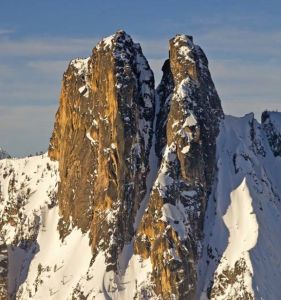Early Winter Couloir, North Early Winters Spire III AI2-3 and M4+ |
||
Washington Pass, Washington, USA | ||
| ||
|
Avg time to climb route: 3-6 hours
Approach time: 1.5-3 hours Descent time: 1.5-3 hours Number of pitches: 6 Height of route: 1,100' Overview
Early Winters Couloir is a fun snow, ice and mixed climb that is in shape early or late in the season. It is usually in condition for two to four weeks after the highway opens and then for a few weeks before it closes. Firm snow that requires no snowshoes for the approach or descent indicates ideal conditions for this route and hopefully climbers will encounter firm snow, ice or Neve in the couloir. This route should never be attempted during warm temperatures or times of higher avalanche danger. It’s mandatory that the freezing level is staying below 5,000 feet for this route to be safely attempted.
Photos
- View all 1 photos of Early Winter Couloir as: Thumbnails | Slideshow
Climber Beta on Early Winter Couloir
Find other routes like
Early Winter Couloir
Route History
First climbed by Washington climbing and skiing legends Gary Brill and Lowell Skoog on May 6, 1978. Skoog was in college at the time and had met Brill a few years earlier. The two were fairly new to climbing and although they were both avid lift skiers, they hadn’t discovered backcountry skiing; something they both subsequently became known for. Their first spring trips up the North Cascades Highway were for climbing, rather than skiing. It all started in May 1977, when Brill and Skoog climbed the east-side couloir that skirts the northeast face of North Early Spire (Lexington side). This was a spur of the moment climb, launched because the weather was too poor for rock climbing. Brill remembers, “Weplaced a few protection pitons along the couloir and had a fun climb, but didn’t reach any summits. We ended the climb where the couloir meets the ridgeline below the North face of North Early Winters Spire. We’d previously had our eye on the couloir between the spires.” As Skog recalls, “Gary had heard of an unsuccessful attempt. So we approached our 1978 climb well prepared with pitons, ice screws and even jumars.” Skoog and Brill cramponed from the car to the base of the upper couloir at sunrise. The pair belayed five pitches in the couloir, which involved easy snow climbing broken by short steps that had Strategy
Early Winters Couloir, only climbed a time or two every year, is a virtually unknown classic. Most people attempt to climb it when the snow is firm enough that the approach does not require snowshoes. In these conditions, not only is the route easier and more fun to climb but you can descend the west side and hike back around to your car. Most parties climb around 5-6 pitches of steep snow and hope to get a little ice climbing. The initial couloir has one steep step right near the bottom and can be around 65-75 degrees before dropping back down to 40 degrees for the rest of the pitch. Pitch 2 is most often 40 degrees with one more steeper section near the top ending at a good rock anchor. After nearly another rope length of 40 degree the route pinches down into a deep chasm, which adds to the ominous feel and is one of the highlights of the route.Starting Pitch 4 there can be a chockstone but is sometimes covered by snow. This chockstone can have fun mixed moves, well-protected with a 3” cam followed by another rope length of 45-50 degrees. Starting Pitch 5, depending on snow conditions there can be another chockstone problem or 65 degree snow. There is usually a cornice at the top of the couloirs, where climbers are often forced to climb a steep AI3 section up the side of the cornice, stemming onto the rock with some rock pro to protect the steepest section or to tunnel through it, Cerro Torre summit mushroom style. Other times the cornice is surprisingly small and you’ll wonder what all the fuss is about. It’s really one of the more variable parts of the route. With a pair of binoculars you can see the conditions of the cornice from the highway. Once the notch is gained, follow the Chockstone Route to the top. What are typically low to mid-5th class slabs on the Chockstone Route feel more like M4 when covered with a little snow and ice and attempted with stiff boots and crampons. Protection on the final pitch is scarce, but the climbing is mellow. Climbers attempting the Early Winters Couloir should have two ice tools each. Bring a few pickets and ice screws, depending on conditions, as well as a light rock rack to 3”, including small nuts and knife blades. Retreat Storm
There are no fixed anchors in the East Couloir and you wouldn’t want to be in there if it’s snowing hard or warming up. Once the notch is gained, you can rappel down on fixed anchors to the west and hike back around to the hairpin.
Everything You Need to Know About
Washington Pass
Search the internet for beta on
Early Winter Couloir
|
Other Routes on North Early Winters Spire
|




